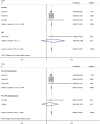Assessment of treatment outcomes: cytoreductive surgery compared to radiotherapy in oligometastatic prostate cancer - an in-depth quantitative evaluation and retrospective cohort analysis
- PMID: 38498388
- PMCID: PMC11175786
- DOI: 10.1097/JS9.0000000000001308
Assessment of treatment outcomes: cytoreductive surgery compared to radiotherapy in oligometastatic prostate cancer - an in-depth quantitative evaluation and retrospective cohort analysis
Abstract
Background: The management of oligometastatic prostate cancer, defined by its few metastatic sites, poses distinct clinical dilemmas. Debates persist regarding the most effective treatment approach, with both cytoreductive surgery and radiotherapy being key contenders. The purpose of this research is to thoroughly evaluate and compare the effectiveness of these two treatments in managing patients with oligometastatic prostate cancer.
Methods: A comprehensive search of the literature was carried out to find pertinent publications that compared the results of radiation and cytoreductive surgery for oligometastatic prostate cancer. A meta-analysis was conducted in order to evaluate both short-term and long-term survival. Furthermore, utilizing institutional patient data, a retrospective cohort research was conducted to offer practical insights into the relative performances of the two treatment regimens.
Results: Five relevant studies' worth of data were included for this meta-analysis, which included 1425 patients with oligometastatic prostate cancer. The outcomes showed that, in comparison to radiation, cytoreductive surgery was linked to a substantially better cancer-specific survival (CSS) [hazard ratio (HR): 0.70, 95% (CI): 0.59-0.81, P <0.001] and overall survival (OS) [HR, 0.80; 95% (CI), 0.77-0.82; P <0.01]. The two therapy groups' Progression-Free Survival (PFS) and Castration-Resistant Prostate Cancer-Free Survival (CRPCFS), however, did not differ significantly (HR: 0.56, 95% CI: 0.17-1.06; HR: 0.67, 95% CI: 0.26-1.02, respectively). Out of the 102 patients who were recruited in the retrospective cohort research, 36 had cytoreductive surgery (CRP), 36 had radiation therapy (primary lesion), and 30 had radiation therapy (metastatic lesion). The follow-up time was 46.3 months (18.6-60.0) on average. The enhanced OS in the CRP group [OS interquartile range (IQR): 45-60 months] in comparison to the radiation group (OS IQR: 39.0-59.0 months and 25.8-55.0 months, respectively) was further supported by the cohort research. Furthermore, CRP had a better OS than both radiation (primary region) and radiotherapy (metastatic region), with the latter two therapeutic methods having similar OS.
Conclusion: This meta-analysis and retrospective research provide valuable insights into the comparative efficacy of cytoreductive surgery and radiotherapy for oligometastatic prostate cancer. While short-term survival (PFS, CRPCFS) was similar between the two groups, cytoreductive surgery exhibited superior CSS and OS. Adverse event rates were manageable in both modalities. These findings contribute to informed treatment decision-making for clinicians managing oligometastatic prostate cancer patients. Further prospective studies and randomized controlled trials are essential to corroborate these results and guide personalized therapeutic approaches for this distinct subset of patients.
Copyright © 2024 The Author(s). Published by Wolters Kluwer Health, Inc.
Conflict of interest statement
No relevant conflicts of interest.
Figures






References
-
- Sandhu S, Moore CM, Chiong E, et al. Prostate cancer. Lancet 2021;398:1075–1090. - PubMed
-
- Lecouvet FE, Oprea-Lager DE, Liu Y, et al. Use of modern imaging methods to facilitate trials of metastasis-directed therapy for oligometastatic disease in prostate cancer: a consensus recommendation from the EORTC Imaging Group. Lancet Oncol 2018;19:e534–e545. - PubMed
-
- Ost P, Reynders D, Decaestecker K, et al. Surveillance or metastasis-directed therapy for oligometastatic prostate cancer recurrence: a prospective, randomized, multicenter phase II trial. J Clin Oncol 2018;36:446–453. - PubMed
-
- Boeri L, Sharma V, Karnes RJ. Radiotherapy for newly diagnosed oligometastatic prostate cancer. Lancet 2018;392:2327–2328. - PubMed
Publication types
MeSH terms
LinkOut - more resources
Full Text Sources
Medical
Research Materials
Miscellaneous

